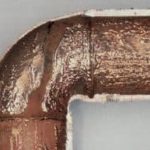Blue Stains in Sink From Well Water
What Does It Mean if You Have Blue Stains in Sink From Well Water?

If you have well water, any stain or smell that comes from your appliances may make you feel concerned. Blue stains in sinks from well water are not usually harmful, but they can become a problem if they are not addressed. Learn more about what causes these blue stains, how to clean them, and how to prevent them from recurring.
What Causes Blue Stains in Sink From Well Water?
Though blue stains may look like an artificial substance or dye causes them, they're typically the result of a natural process. Blue stains in sinks from well water are usually caused by one of the two reasons below. You should always consider investing in a professional testing kit or service before diagnosing strange-looking water by yourself.
Copper Pipes
Copper pipes are generally considered safe, but if the water sits inside them too long, the mineral may begin to dissolve. This causes the blue-green stains that you see in a light-colored sink. Another tip-off that your drinking water has too much copper in it is that it will taste a little bit metallic.
Acidity in Your Water
You may remember studying pH, acids, and bases as far back as high school chemistry class. When your water's pH level is too low, it begins to cause corrosion in your pipes. Your pipes become less stable as they corrode, and you may notice blue stains in the sink from well water due to the water's high mineral content.
Should I Use a Filter?
Using an under-the-counter filter can be a start for people who want fresher-tasting water, but until you know what is wrong with your well water system, it's not a good idea to buy a filter and consider the problem fixed. Blue stains in the sink from well water can represent a significant problem. Copper in excess amounts can be extremely dangerous to human health and completely ruin your copper pipes. This can end up causing very expensive re-piping.
First, you should have your water professionally tested. Your next step should be to treat it appropriately. If your water is low in pH (acid) this is very simple to fix with a calcite acid neutralizer.
Fix Your Blue Stains in Sink From Well Water Today
Blue stains in sinks often point to corrosive water and copper pipe issues, especially when using well water. Start by identifying the source and severity:
- Inspect your plumbing for signs of corrosion, improper grounding, or sections where copper pipes are interrupted by plastic fittings. Use jumper cables to restore continuity if needed.
- Test your water using a corrosion test kit. Check pH, hardness, alkalinity, total dissolved solids (TDS), and temperature. Calculate the LSI (Langelier Saturation Index) to assess corrosiveness.
- Inspect pipe interiors for corrosion. Replace any sections with severe damage.
- Install a calcite neutralizer tank to raise pH to 7.2–8.0 and improve alkalinity.
- Use a phosphate feeder to coat pipe interiors and minimize corrosion.
- If TDS levels exceed 1000 ppm, install a whole-house reverse osmosis system followed by a neutralizer.
- For bacteria or sulfur odors, use a chlorinator or ozone system to disinfect the water.

City Water Users: Call your water utility and report the issue. It may be due to grounding problems or installation flaws.
Well Water Users: Start with a full water analysis. Test for pH, hardness, alkalinity, TDS, iron, manganese, sulfate, and copper.
Don’t ignore blue stains—they can signal long-term pipe damage. Clean Water Store offers expert testing kits and treatment systems to help you resolve the issue and protect your home’s water quality.
Resources:
Best Plumbing Practices to Eliminate Copper Corrosion
https://www.copper.org/applications/plumbing/
https://www.wikihow.com/Remove-Copper-Stains-from-Baths-and-Showers
Frequently Asked Questions (FAQs)
1. Are blue stains in my sink dangerous?
Blue stains are usually caused by copper leaching from pipes due to acidic water. While small amounts aren't typically harmful, high levels of copper can pose health risks over time—especially for infants and people with certain health conditions.
2. Can I drink well water that causes blue stains?
It’s best to test your water before continuing to drink it. Blue stains suggest elevated copper levels or low pH, which can indicate corrosive water. Drinking water with excess copper can, over time, lead to nausea, stomach issues, and more serious health problems.
3. Will a water filter remove the copper that causes blue stains?
Some filters can reduce copper, but not all. Treating the root cause, such as low pH, with a calcite neutralizer or installing a phosphate feeder to coat the pipes and reduce corrosion is more effective.
4. How do I permanently get rid of blue stains in my sink?
Using a neutralizer system, the most effective way is to raise your water’s pH level to neutral or slightly alkaline. This helps stop corrosion and prevents copper from leaching into your water. Proper grounding and pipe inspection may also be necessary.
5. To fix the issue, What should I test for in my well water?
Start with a comprehensive water test that includes pH, copper, total dissolved solids, alkalinity, hardness, and LSI (Langelier Saturation Index). These results will guide you toward the right treatment system for your home.














